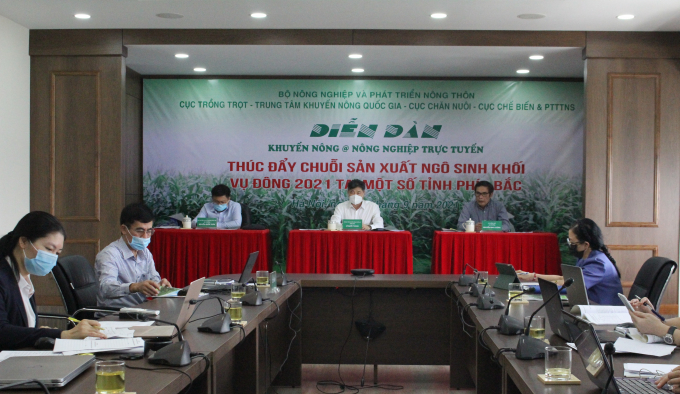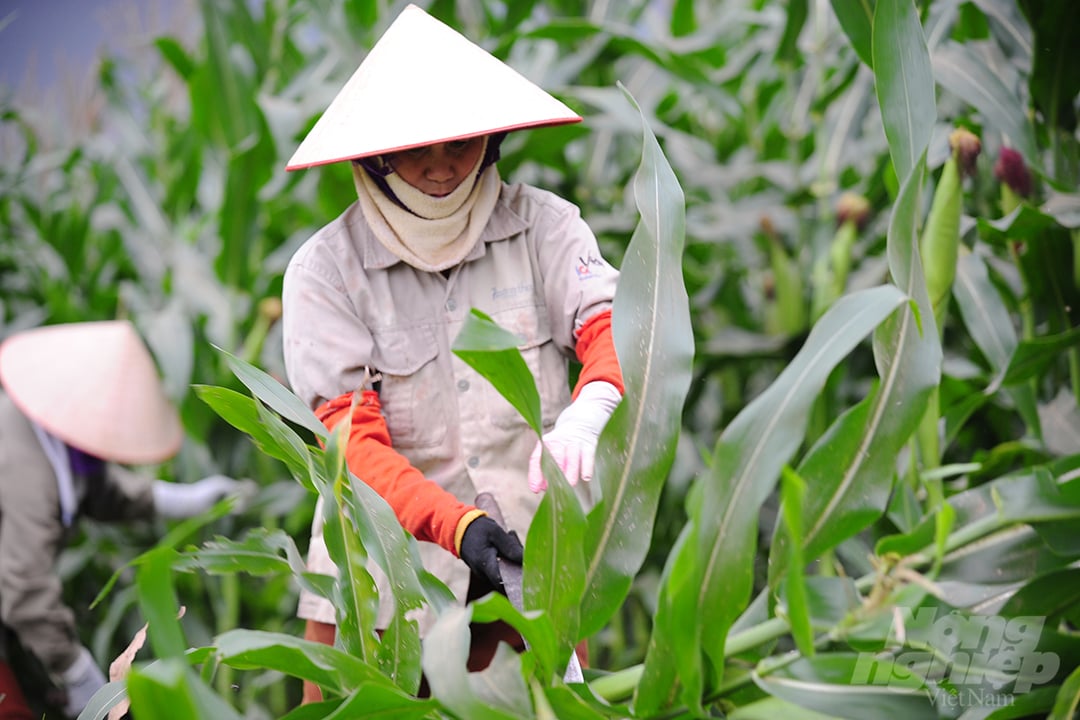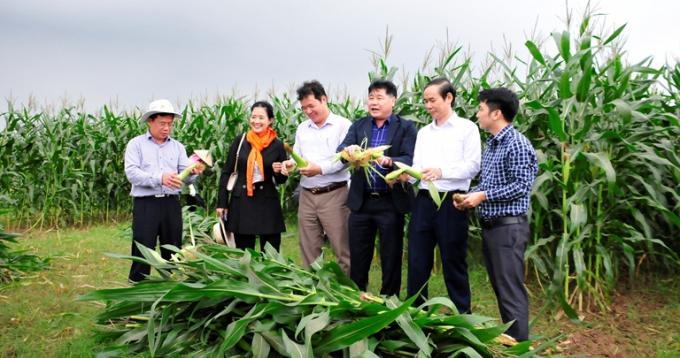May 27, 2025 | 19:50 GMT +7
May 27, 2025 | 19:50 GMT +7
Hotline: 0913.378.918
May 27, 2025 | 19:50 GMT +7
Hotline: 0913.378.918
On September 16, the National Center for Agricultural Promotion in collaboration with the Department of Crop Production, Department of Livestock Production, Department of Agricultural Processing and Market Development (Ministry of Agriculture and Rural Development), and the Maize Research Institute held an online forum titled "Promoting the Production Chain of Biomass Maize in Winter 2021 in some Northern Provinces".

The forum was held in the form of both offline and online, with the participation of many units, businesses and localities that thrived on biomass maize in the North. Photo: Trung Quan.
According to the National Center for Agricultural Promotion, in recent years, livestock breeding in our country has developed strongly. In particular, raising high-quality dairy cows and beef is identified as one of the advantageous livestock products, bringing high economic efficiency to farming households.
As of 2021, the country has about 2.3 million buffaloes, 5.9 million cows for meat and 332,000 dairy cows. Grasping the continuously increasing demand for forage for livestock, many localities have actively converted farming in low-yield maize areas into growing maize as feed for livestock.
Biomass maize has been strongly developed recently in provinces such as Thanh Hoa, Nghe An, Vinh Phuc and Son La. In 2020, the area of biomass corn was over 100,000 hectares with the output reaching nearly 450,000 tons and the link chain constantly expanding.
Calculations estimate that 1ha of maize cultivated for stem in 80 - 85 days will give a yield of 40-45 tons/ha/crop. With a selling price of VND850,000-1 million/ton, farmers earn about VND34-40 million, minus costs they will get profit from VND24-30 million/ha/crop. Thus, with 1ha of biomass corn, farmers can cultivate three crops per year, helping them earn about VND80-90 million/year, much higher than other crops.

Biomass maize is a good choice for winter crops in the northern provinces. Photo: TL.
With the orientation of increasing the beef farming to 10% of the total carcass scheme, it is estimated that the whole country will need about 234,000 ha of biomass corn (continuously growing all three crops/year) to meet the demand for green forage.
Mr. Le Quoc Thanh, Director of the National Center for Agricultural Promotion, said: “The winter crop of 2021 takes place in a very special context. Many provinces and cities are implementing social distancing. The issue of realizing the dual goals of both fighting the pandemic and maintaining production, without breaking the production chain is posing a great responsibility to localities."
In the past, maize accounted for a quarter of the general structure of winter crops in many localities. However, there was a period when many localities used corn varieties for seeds and old sets of maize varieties, so the yield and added value were not high.
In recent years, as demands for green forage for livestock herds in the North during the cold winter, or for beef cattle grown in the industrial direction is more and more increasing in the orientation of boosting sustainable agriculture following the development chain of the Ministry of Agriculture and Rural Development, especially in developing the large cattle breeding areas, biomass maize is a target that needs to be reached with certain advantages.

Biomass maize has a great potential for raising in the winter crop in the northern provinces. Photo: TL.
Besides, the room area for the development of biomass maize in our country is still quite large. Annual demand for forage for livestock is about 75 million tons. The area can be expanded more largely for maize biomass growing.
In addition to converting the production structure of maize for grain into biomass maize in specialized maize-growing areas, it is possible to exploit the fallow land of spring crop in the northern mountain regions which is covering about 100,000 ha and winter land after two rice crops in the northern mountain midlands and the Red River Delta provinces which is about 200,000 ha.
However, to continue the sustainable development of biomass maize cultivation, there are many issues that need to be concerned about and resolved. From experiences, initiatives, and good practices implemented in the previous winter crop and in winter 2021, it is expected to create a "push" to increase sharply in area, output, production, and consumption links between producers and enterprises to continuously and steadily grow. Forming biomass maize production areas is also necessary to ensure quantity and quality for sustainable livestock development.
Mr. Nguyen Nhu Cuong, Director of the Department of Crop Production said: “Currently, the growing and production areas of of biomass maize in the winter crop in northern provinces are constantly increasing. However, small-scale farming model still occupies quite a large area. Biomass maize instead is considered as an easy plant to grow with short time for harvest and easy to spread to large areas.
Moreover, biomass corn is grown mainly to serve as animal feed, so if there is no unstable consumption market, it could likely face the risk of supply exceeding demand and a reduce in the quality due to the mass growing.
Therefore, the biggest problem in cultivation of biomass maize in winter 2021 is to create a sustainable chain of links between producers and consumers. Ensuring sustainable development and creating high added value for crop products have become important factors in the development of the livestock industry."
Translated by Linh Nguyen
/2025/05/25/4127-3-073637_820.jpg)
(VAN) Thanks to the promotion from an FAO-implemented project, vegetable production in greenhouses in Moc Chau has seen strong development, from 1.5 hectares in 2021 to nearly 50 hectares in 2024.

(VAN) FAO has recently supported USD 140,000 to implement the project 'Risk mitigation human-animal interface risks through disease control initiatives in pig farming.'

(VAN) The People's Committee of Tra Vinh province has approved an adjustment to the investment policy for the Green Hydrogen Plant project, increasing its area to approximately 52.76 hectares.
![Reducing emissions from rice fields: [2] Farmers’ commitment to the soil](https://t.ex-cdn.com/nongnghiepmoitruong.vn/608w/files/news/2025/05/05/dsc08881jpg-nongnghiep-140632.jpg)
(VAN) Clean rice cultivation model in Thuong Tan commune, Bac Tan Uyen district, is assisting local residents in achieving sustainable agriculture by substantially reducing costs, increasing productivity, and protecting the environment.

(VAN) At the conference to disseminate Resolution No. 68, AgriS introduced its digital agricultural ecosystem and reaffirmed its commitment to accompanying the Government in promoting private sector development and sustainable agriculture.

(VAN) 'Blue Ocean - Blue Foods' initiative is designed to restore marine ecosystems and establish sustainable livelihoods for local communities by cultivating a minimum of 1,000 hectares of cottonii seaweed in the first three years.
/2025/05/21/4642-3-112707_603.jpg)
(VAN) The V-SCOPE project has made direct contributions to three out of six pillars of the Comprehensive Strategic Partnership between Vietnam and Australia.